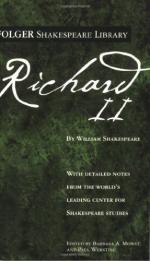|
This section contains 10,560 words (approx. 36 pages at 300 words per page) |

|
SOURCE: Ruiter, David. “‘Awhile To Work, And After Holiday’: Richard II and the Roots of a Festive History.” In Shakespeare's Festive History: Feasting, Festivity, Fasting, and Lent in the Second Henriad, pp. 41-68. Aldershot, U.K.: Ashgate, 2003.
In the following essay, Ruiter maintains that festivity is a central theme in Richard II that becomes more fully developed in the succeeding plays of the second tetralogy. According to the critic, the common masses support Richard's deposal and Bolingbroke's subsequent ascension to the throne because the king dismisses community festivity whereas his challenger recognizes its importance to social stability.
At least since 1959, when C. L. Barber included the two parts of Henry IV in his famous book, Shakespeare's Festive Comedy: A Study of Dramatic Form and Its Relation to Social Custom, there has been little doubt that Shakespeare's history plays not only contain festive elements, but that understanding the function...
|
This section contains 10,560 words (approx. 36 pages at 300 words per page) |

|


